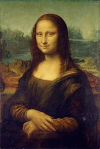The psychology of Mona Lisa's smile
- PMID: 38806507
- PMCID: PMC11133332
- DOI: 10.1038/s41598-024-59782-1
The psychology of Mona Lisa's smile
Abstract
Mona Lisa's ambiguous expression, oscillating between melancholy and contentment, has captivated viewers for centuries, prompting diverse explanations. This article proposes a novel interpretation grounded in the psychological theory of perceptual organisation. Central to the investigation is the "Ambiguity-Nuance", a subtly shaded, blended region framing the upper part of the lips, hypothesised to influence perceived expression due to perceptual organization. Through carefully crafted artwork and systematic manipulations of Mona Lisa reproductions, experiments reveal how alterations in the perceptual relationships of the Ambiguity-Nuance yield significant shifts in perceived expression, explaining why Mona Lisa's appearance changes and under which conditions she looks content versus melancholic based on perceptual organization. These findings underscore the pivotal role of psychological principles in shaping ambiguous expressions in the Mona Lisa, and extend to other Leonardo's portraits, namely La Bella Principessa and Scapigliata. This study sheds light on the intersection of psychology and art, offering new perspectives on timeless masterpieces.
Keywords: Ambiguity-Nuance; Facial expression; Mona Lisa; Perceptual organisation.
© 2024. The Author(s).
Conflict of interest statement
The author declares no competing interests.
Figures







Similar articles
-
Investigating the 'Uncatchable Smile' in Leonardo da Vinci's La Bella Principessa: A Comparison with the Mona Lisa and Pollaiuolo's Portrait of a Girl.J Vis Exp. 2016 Oct 4;(116):54248. doi: 10.3791/54248. J Vis Exp. 2016. PMID: 27768043 Free PMC article.
-
Looking Into Mona Lisa's Smiling Eyes: Allusion to an Illusion.Front Hum Neurosci. 2022 Jul 1;16:878288. doi: 10.3389/fnhum.2022.878288. eCollection 2022. Front Hum Neurosci. 2022. PMID: 35845241 Free PMC article.
-
The uncatchable smile in Leonardo da Vinci's La Bella Principessa portrait.Vision Res. 2015 Aug;113(Pt A):78-86. doi: 10.1016/j.visres.2015.05.014. Epub 2015 Jun 4. Vision Res. 2015. PMID: 26049039
-
[Mona Lisa syndrome: idiopathic facial paralysis during pregnancy].Z Geburtshilfe Neonatol. 2006 Aug;210(4):126-34. doi: 10.1055/s-2006-947216. Z Geburtshilfe Neonatol. 2006. PMID: 16941305 Review. German.
-
Visualizing and analyzing the Mona Lisa.IEEE Comput Graph Appl. 2007 Nov-Dec;27(6):60-8. doi: 10.1109/mcg.2007.162. IEEE Comput Graph Appl. 2007. PMID: 18027798 Review.
References
-
- Gombrich EH. The Story of Art. Phaidon; 1995.
-
- Kemp M. Leonardo Da Vinci: The Marvellous Works of Nature and Man. Oxford University Press; 2007. - PubMed
-
- Sassoon D. Becoming Mona Lisa: The Making of a Global Icon. Mariner Books; 2001.
-
- Wertheimer M. Untersuchungen zur lehre von der gestalt II [laws of organization in perceptual forms] Psychol. Forsch. 1923;4:301–350. doi: 10.1007/BF00410640. - DOI
Publication types
MeSH terms
LinkOut - more resources
Full Text Sources

